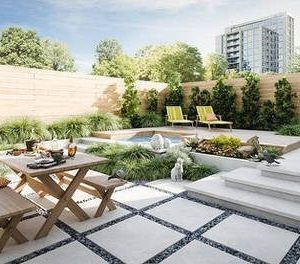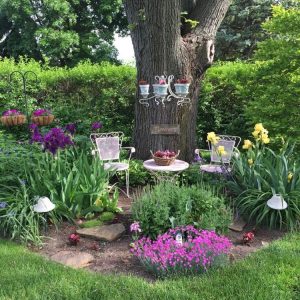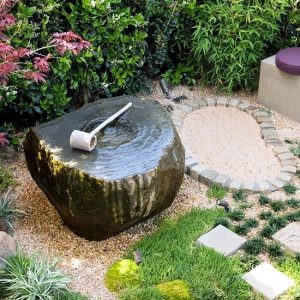
A Zen garden, also known as a Japanese rock garden, is a unique and beautiful way to create a serene and peaceful space in your outdoor area.
It is a carefully designed and arranged landscape that combines rocks, gravel, sand, and sometimes moss or plants to create a miniature representation of nature.
Zen gardens have a long history and are deeply rooted in Japanese culture and spirituality. They’re structured around seven guiding principles: Austerity (Koko), simplicity (Kanso), naturalness (Shinzen), asymmetry (Fukinsei), mystery or subtlety (Yugen), magical or unconventional (Datsuzoku), and stillness (Seijaku).
Zen gardens were originally developed by Japanese Buddhist monks as places of meditation in temples, but they’re now used in many private meditative backyard spaces or other work environments. Many homeowners are also opting for a mini zen garden in their backyards.
These spaces utilize rocks, gravel, sand, wood, and water features for the ideal meditative space. Traditionally, very few plants and water elements are implements but you can rake and shape sand or gravel into formations that represent ocean waves. But you can also add your own spin to these serene gardens.
In this article, I’ll cover everything you need to know about zen gardens, as well as their benefits and how you can get started with one today.
What is a Zen Garden?
A Zen garden, often called a “dry landscape” garden, is a type of garden that originated in Japan centuries ago. It is designed to evoke a sense of tranquility, simplicity, and harmony with nature.
Zen gardens are traditionally small, enclosed spaces that are intended for quiet contemplation and meditation. The design of a Zen garden typically consists of carefully arranged rocks, raked gravel or sand, and minimalistic plantings, such as moss or shrubs.
The main purpose of a Zen garden is to create a space for mindfulness and reflection. The carefully selected elements in a Zen garden, including the rocks and gravel, are meant to symbolize different natural elements, such as mountains, islands, or flowing water.
The simplicity and minimalist design encourage a sense of calm and focus, allowing you to disconnect from the outside world and find inner peace.
And if you’re wondering if zen gardens are low-maintenance, then yes they absolutely are! It wouldn’t be one if it weren’t. Even though bonsai trees and gravel paths do require some maintenance, raking and trimming should be a meditative activity that encourages mindfulness and inner peace.
Why Do You Need a Zen Garden?
Having a Zen garden in your outdoor space can bring numerous benefits to your physical, mental, and emotional well-being. In today’s fast-paced and hectic world, finding moments of peace and tranquility is essential for our overall health and happiness.
A Zen garden provides you with a dedicated space to relax and unwind. The act of tending to your garden, raking the gravel or sand, and rearranging the rocks can be a meditative and therapeutic activity in itself.
It allows you to focus your mind, relieve stress, and find inner balance. The peaceful atmosphere of a Zen garden can also help to reduce anxiety and promote a sense of serenity.
In addition to the mental and emotional benefits, a Zen garden can also enhance the visual appeal of your outdoor space.
The carefully arranged rocks and gravel create a visually pleasing and harmonious landscape that can be enjoyed by both you and your guests. It adds a touch of elegance and sophistication to your garden, making it a peaceful sanctuary that blends seamlessly with nature.
Ultimately, a Zen garden is not just a decorative addition to your outdoor space; it is a sanctuary for your mind, body, and soul. It offers a respite from the chaos of daily life and provides an opportunity for self-care and rejuvenation.
Whether you choose to meditate, practice yoga, or simply sit in quiet contemplation, a Zen garden can be a transformative and enriching experience.
How to Use a Zen Garden
Using a Zen garden is a simple yet profound experience. When you enter your garden, leave behind all your worries and distractions. Take a few deep breaths and allow yourself to be fully present in the moment.
As you step onto the soft gravel or sand, feel the gentle texture beneath your feet. Close your eyes for a moment and listen to the rustling of leaves in the nearby trees. Let the tranquility of the garden wash over you, like a soothing balm for the soul.
You can start by gently raking the gravel or sand with a wooden rake. The act of raking is a form of meditation and can help to clear your mind and create a sense of calm.
As you rake, focus on the patterns you create and the sound of the rake against the surface. Allow your thoughts to drift away and find peace in the simplicity of the task.
Observe how the wavy lines you create with the rake mimic the ebb and flow of life itself. Each stroke of the rake represents a moment of mindfulness, a moment of letting go. As you continue to rake, notice how your breathing becomes slower and more rhythmic, syncing with the gentle movements of the rake.
You can also spend time rearranging the rocks and other elements in your Zen garden. Experiment with different arrangements and find a design that resonates with you. The process of arranging the rocks can be a metaphor for finding balance and harmony in your own life.
Remember, there is no right or wrong way to use a Zen garden. It is a personal and individual experience. Find what brings you joy and peace, and allow yourself to fully immerse in the present moment.
Find Your Zen Garden Style
There are various styles of Zen gardens, each with its own unique characteristics and symbolism. Discovering which style resonates with you can help you create a garden that reflects your personality and preferences.
- Karesansui, or dry landscape style, is the most well-known type of Zen garden. It features carefully arranged rocks and gravel, often symbolizing mountains, islands, or water. Moss or shrubs may be added to provide a touch of greenery.
- Tsubo-en, or courtyard style, is a small-scale Zen garden that is often enclosed by walls or fences. It provides a private and intimate space for contemplation. Tsubo-en gardens typically incorporate elements like stepping stones, lanterns, and water basins.
- Chisen-shoyu, or pond style, incorporates water features into the Zen garden. A pond or small water basin serves as the focal point, surrounded by rocks, plants, and bridges. The presence of water enhances the sense of tranquility and adds another layer of symbolism.
How to Create a Zen Garden
Creating your Zen garden can be a fulfilling and rewarding experience. The process of designing and building your own tranquil oasis can bring a sense of peace and serenity to your outdoor space. Here are some steps to guide you in the process:
1. Choose the Perfect Location
Select a space in your outdoor area that is quiet and secluded. Ideally, it should be a spot that receives adequate sunlight and is away from distractions or noise.
This will allow you to fully immerse yourself in the calming atmosphere of your Zen garden.
2. Plan the Layout
Consider the size and shape of your garden. Sketch out a rough plan of how you want to arrange the rocks, gravel, and other elements.
Keep in mind the principles of simplicity and balance. Think about how the different elements will interact with each other and create a harmonious composition.
3. Prepare the Ground
Before you can start building your Zen garden, you need to prepare the ground. Clear the area from any debris or vegetation.
Level the ground and create a base for your Zen garden using sand or gravel. This will provide a stable foundation for the rocks and other elements.
4. Select the Rocks
Rocks are an essential element of a Zen garden. Choose rocks that have an appealing shape and texture. You can gather them from nature or buy them from a garden supply store.
Take your time to find rocks that resonate with you and create a sense of tranquility. Arrange the rocks in a way that creates a harmonious composition, keeping in mind the principles of balance and simplicity.
5. Add Gravel or Sand
Once you have arranged the rocks, it’s time to add a layer of fine gravel, sand, or small pebbles to your Zen garden.
This layer will serve as a blank canvas for you to create patterns or lines, simulating the movement of water or the flow of energy. Use a rake to carefully create these patterns, allowing your creativity to flow freely.
6. Add Additional Elements
Depending on your chosen style, you can add additional elements to enhance the aesthetic appeal of your Zen garden.
Moss can be added to create a lush and serene atmosphere. Shrubs can be strategically placed to add a touch of greenery.
Lanterns can be incorporated to provide soft and warm lighting during the evening hours. Consider these elements carefully and choose ones that resonate with your vision of a peaceful sanctuary.
7. Other Elements to Consider
To give your zen garden a stunning secluded feel, you can enclose the area with a wall, fencing, or bamboo screening for the best backyard zen garden.
8. Maintain Your Zen Garden
Once your Zen garden is complete, it’s important to maintain it regularly. Rake the gravel or sand to keep it neat and clean. This will help to maintain the sense of order and tranquility in your garden.
Trim any overgrown plants or moss to maintain the balance and harmony of your garden. Take the time to appreciate and care for your Zen garden, as it will continue to provide you with a sense of peace and serenity.
By following these steps, you can create a Zen garden that not only reflects your personal style but also provides a space for relaxation and contemplation.
Materials for Your Garden
When creating a Zen garden, it is important to carefully select the materials that will be used. The choice of materials can significantly impact the overall aesthetic and atmosphere of your garden.
For the base, you can use fine gravel or sand. Both options create a smooth and calming surface that can be easily raked. Gravel is often preferred for larger gardens, while sand is commonly used for smaller, more intricate designs.
When selecting rocks for your garden, consider their shape, size, and color. Look for rocks that have interesting textures or patterns. The rocks should fit well together and create a sense of balance and harmony. Remember to thoroughly clean the rocks before placing them in your garden to remove any dirt or debris.
In addition to gravel or sand and rocks, there are other materials that can enhance the beauty and tranquility of your Zen garden. One such material is moss. Moss can be used to create a lush and vibrant green carpet that adds a touch of nature to your garden. It thrives in moist and shady areas, so consider placing it in areas that receive less direct sunlight.
Bamboo is another material commonly used in Zen gardens. Its tall and slender stalks can add vertical interest and create a sense of movement in your garden. Bamboo can be used as a fence or as a decorative element, adding a touch of elegance and serenity to the overall design.
Water features, such as small ponds or fountains, can also be incorporated into your Zen garden. The sound of flowing water can have a calming effect and create a peaceful ambiance. Consider adding water lilies or other aquatic plants to enhance the natural beauty of the water feature.
Aside from the materials mentioned above, you can also consider adding stepping stones, lanterns, or even a small bridge to your Zen garden. Stepping stones can create a path for you to walk on and explore the garden, while lanterns can provide soft and warm lighting during the evening hours. A small bridge can add a touch of whimsy and create a focal point in your garden.
Remember, the materials you choose for your Zen garden should reflect your personal style and preferences. Experiment with different combinations and arrangements to create a space that brings you peace and tranquility. With careful selection and placement, your Zen garden will become a sanctuary where you can find solace and reconnect with nature.
How to Care for Your Zen Garden
Like any other garden, a Zen garden requires regular maintenance to keep it looking its best. With a few simple steps, you can ensure that your garden remains a tranquil and inviting space:
- Regular raking: Set aside some time to rake the gravel or sand in your Zen garden. This helps to maintain the smooth appearance and allows you to create new patterns or lines.
- Weeding: Keep an eye out for any weeds or unwanted plants that may sprout in your garden. Remove them promptly to maintain the clean and minimalist aesthetics.
- Trimming: If you have added moss or shrubs to your Zen garden, periodically trim them to prevent overgrowth. This ensures that the plants remain in balance with the rest of the garden.
- Cleaning: Occasionally, use a soft brush or cloth to gently clean the rocks and other elements in your garden. This helps to remove any dust or debris that may accumulate over time.
A well-maintained Zen garden will continue to provide you with a sense of tranquility and relaxation for years to come.
Whether you live in a bustling city or a quiet countryside, creating a Zen garden allows you to escape from the demands of everyday life and find solace in nature. It is a sanctuary where you can find stillness amidst the chaos, and discover the beauty of simplicity.
So, why not consider having a Zen garden? You deserve a space where you can find balance, inspiration, and inner peace.
Other Guides from Planet Natural:
34 Best Low Light Indoor Plants & Our Favorite Houseplants in 2023
How to Grow and Care for Air Plants (No Soil Required)
Melissa Pino is a biologist, master gardener, and regular contributor for Planet Natural. Melissa’s work focuses on promoting environmentally-friendly practices, helping people create healthy gardens and finding ways to achieve overall health and wellness.

























